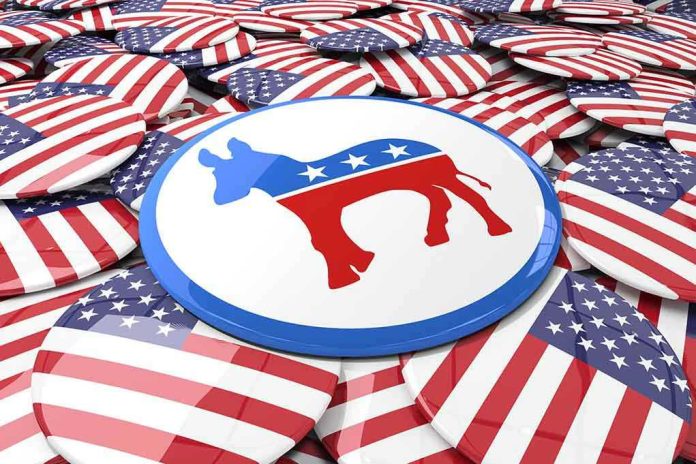
The Democratic Party’s age crisis isn’t just an embarrassing headline—it’s a generational earthquake reshaping its leadership, elections, and very identity, as younger challengers confront a wall of entrenched power built over decades.
Story Overview
- Internal Democratic Party battles now center not on ideology, but on the age and longevity of its leadership.
- Younger candidates are mounting unprecedented primary campaigns against senior incumbents, demanding generational change.
- President Biden’s 2024 withdrawal due to health concerns has triggered a cascade of new challenges and retirements.
- Polls and public forums reveal a party base deeply dissatisfied with its aging leadership and hungry for new faces.
Entrenched Seniority Faces an Unruly Youthquake
In 2024, the Democratic Party’s most urgent wound is self-inflicted: a yawning generational chasm that has become impossible to paper over. The average age of Democratic House members hit 72 last year, a statistic more befitting a retirement village than a party seeking to lead a dynamic nation. This is not merely a quirk of demographics. It is the product of decades of institutional inertia, where seniority begets power and incumbency is shielded by party machinery.
President Joe Biden’s withdrawal from his re-election campaign in early 2024—at age 81 and amid visible health struggles—ripped open this wound for all to see. Suddenly, what had simmered beneath the surface burst into the open: younger Democrats, frustrated by what they see as complacency and a lack of urgency, began launching primary challenges against long-serving incumbents. They argue that the party’s leadership has grown disconnected from the realities of modern America and is ill-equipped to counter Republican advances in a rapidly shifting political landscape.
The New Insurgents: Generational Rebellion Goes Public
This wave differs from past insurgencies. It is less about left versus center and more about old versus new. Candidates like Jake Rak, Tuber Abugazale, Saikat Chakrabarti, and George Hornedo have stepped up in districts long regarded as fiefdoms of senior Democrats—including Rep. Brad Sherman, Rep. Schakky, and even icons like Nancy Pelosi and Rep. Andre Carson. These young challengers leverage social media and grassroots momentum to bypass traditional power brokers, making their campaigns harder to contain or dismiss.
The pushback from party elders has been forceful and sometimes explicit. George Hornedo publicly recalled a senior Democrat warning him against challenging Rep. Carson, a moment that crystallized the party’s internal resistance to generational turnover. Yet such warnings have only fueled the determination of the insurgents and their supporters, who see these tactics as proof of the need for change. Town halls and polls now routinely reflect simmering discontent, particularly among younger and more progressive voters who feel ignored by leadership that seems out of step with their lives.
Leadership Vacuum and Identity Crisis: The Party’s Next Act
The Democratic Party now faces a leadership vacuum with no obvious heir apparent. The old guard—still led by figures like Senate Minority Leader Chuck Schumer—clings to institutional memory and the argument that experience should not be discarded lightly. Yet the base is restless, and many influential consultants, including Rebecca Katz, predict that more primaries and retirements are on the horizon as the party stumbles toward reinvention.
Age Is the Issue That Democrats Can’t Shut Down https://t.co/7N72QxaA3G
— BixbyRme (@BixbyRme77407) November 11, 2025
This generational conflict has thrown the party’s identity into flux. The familiar faces that once symbolized Democratic strength now symbolize its inability to adapt. Analysts and columnists, including Elwood Watson, argue that the party’s age problem is not just a matter of optics; it undermines the Democrats’ ability to connect with younger voters and respond to the challenges of the post-Trump era. The 2024 presidential loss, with Donald Trump returning to the White House, has only intensified the sense of crisis and urgency.
What Comes Next: Opportunity or Fragmentation?
The short-term impact is already visible: an uptick in primary contests, retirements, and public squabbles over the direction of the party. The risk of fragmentation is real, with some warning that internecine battles could weaken the party’s ability to oppose Republican policies effectively. However, others see the turmoil as a necessary prelude to renewal. If the insurgents succeed, Democrats may finally see a generational shift that brings new energy, perspectives, and policy priorities into the fold.
Longer term, the outcome will define not only the party’s leadership but its soul. Will the Democrats become a more responsive, dynamic force capable of challenging Republican dominance and engaging the next generation? Or will the party’s reluctance to let go of the past cement its decline? The only certainty is that age—once an unspoken subtext—has become the inescapable headline. The battle for the party’s future has just begun, and the outcome is anything but predetermined.
Sources:
Politico: Democrats’ Age Problem Fuels Primary Challenges
My Journal Courier: Democrats Still Have an Age Problem
The Politic: The Headless Party—Inside the Democrats’ Search for Identity in the Age of Trump













